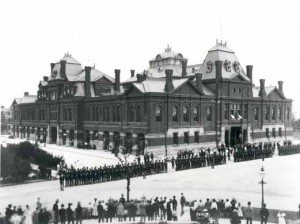
Back a couple weeks ago, President Obama was in town to declare the Pullman Historic District a National Monument. And a couple days ago, Tribune columnist Ron Grossman wrote a great piece, “History mugged in recent Pullman coverage,” the gist of which is that the history of that site is being grossly misrepresented by Obama, the media, and the site’s cheerleaders in general.
The site is, as you may know from your history books, the location of the former company town set up by George Pullman for the workers manufacturing sleeping cars for rail lines. Initially, it was a model of employer benevolence, but then, as Grossman summarizes,
In 1894, the workers of Pullman — most white immigrants — went on strike, trapped between wage cuts during a depression and George Pullman’s insistence on their paying the full rents on the apartments he leased them. The American Railway Union backed them, but the strike was broken by a court injunction enforced by federal troops. The union went under, a setback that crippled the labor movement until it was revived during the New Deal era, four decades afterward.
But Obama, and the media, tell another story. The Washington Post calls the area “the birthplace of the nation’s first African American labor union” and Obama implies the same in his speech, though more obliquely, as he simply shifts from discussing the 1894 strike (which he implies succeeded) to the establishment of the Brotherhood of Sleeping Car Porters in 1925, glossing over the fact that the porters themselves had no connection at all to the Pullman district, which, if I remember correctly, had long since ceased to be a company town, and was in any case never home to any of the (black) porters due to segregation. Obama then uses his speech to praise unionization, the Civil Rights Movement, and the modern welfare state, including Social Security and Obamacare (OK, he said “Affordable Care Act”).
(You want a national park memorializing the true birthplace of unionization? I doubt that Ford would turn over the River Rouge factory complex to the National Park Service.)
You can read the Washington Post coverage here, and Obama’s speech here.
Now, this irritates me, in part, because of the inaccuracy of the history lesson being told, and because Obama is using his inaccurate history to promote his politics (and, let’s face it, his praise of Rahm Emanuel just days before an election). But also because this is transforming, and politicizing, the idea of the national park.
I griped about this earlier in my blogging days, here, back when the move contemplated was even bigger, naming the site a National Park — and the Tribune, and local politicians were all for it because of the hope it would bring federal largesse to Chicago.
My first complaint is that National parks used to be about the great natural wonders of the United States. Now, slowly but surely, we’re diluting the brand. We’re bean-counting how many sites are dedicated to specific minority or other interest groups. (Per the Post, “According to an analysis by the liberal Center for American Progress on the country’s 461 national parks and monuments, 26 center on the black community, 19 on Latinos, eight on women and two on Asian Americans.”) Site are being named to be equitable to various regions, including the recent designation of First State National Historic Park in Delaware, celebrated by boosters for the prospect of tourism revenue and as a feel-good for state residents.
But, beyond that, it seems as if this reflects a peculiarly American way of looking at history. I can’t quite articulate it, but it seems as if we’re more likely to want to set apart and freeze-in-time historical sites, where Germans, and presumably Europeans in general, recognize that history is all around them but they can’t turn their entire country into a museum. Germans do have national parks (a list is here), but they are limited to natural areas. And they do have preserved historic sites: Bavaria, for instance, opened Neuschwanstein Castle to tourists a mere six weeks after Ludwig II’s death. The main site connected with Martin Luther is now a museum, and you can visit Beethoven’s birthplace to learn about the composer — not to mention the various concentration camps. But other sites continue to be used, with historical markers, of course. The Fuggerei, the world’s oldest social housing complex still in use, is, indeed, still in use as housing for the needy. And — in any case — there is no single national authority running all these establishments under the label “national park.”













